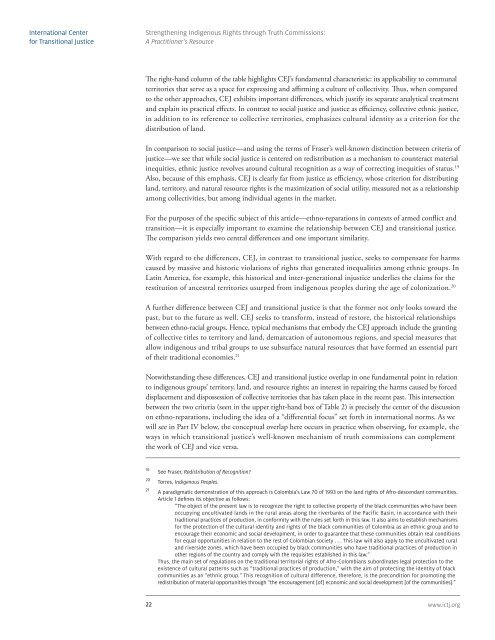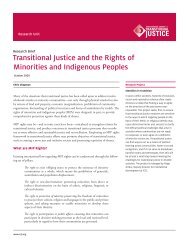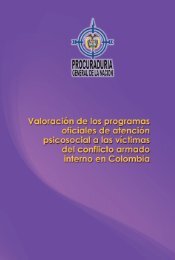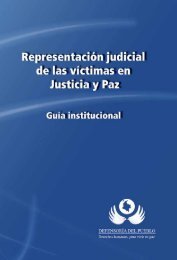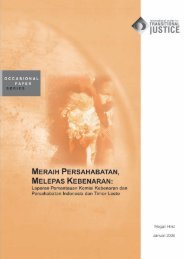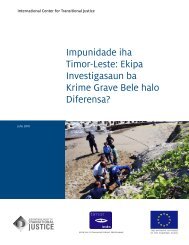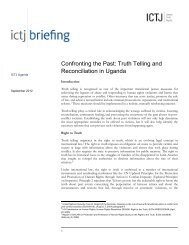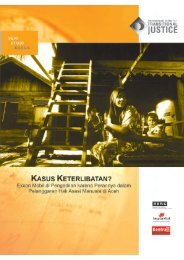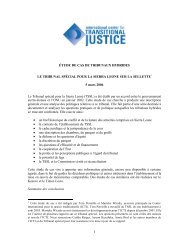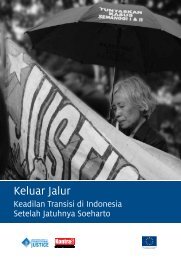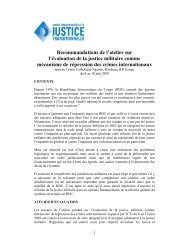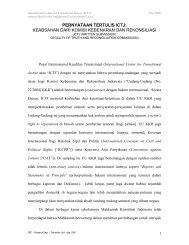Strengthening Indigenous Rights through Truth Commissions: A ...
Strengthening Indigenous Rights through Truth Commissions: A ...
Strengthening Indigenous Rights through Truth Commissions: A ...
- No tags were found...
Create successful ePaper yourself
Turn your PDF publications into a flip-book with our unique Google optimized e-Paper software.
International Centerfor Transitional Justice<strong>Strengthening</strong> <strong>Indigenous</strong> <strong>Rights</strong> <strong>through</strong> <strong>Truth</strong> <strong>Commissions</strong>:A Practitioner’s ResourceThe right-hand column of the table highlights CEJ’s fundamental characteristic: its applicability to communalterritories that serve as a space for expressing and affirming a culture of collectivity. Thus, when comparedto the other approaches, CEJ exhibits important differences, which justify its separate analytical treatmentand explain its practical effects. In contrast to social justice and justice as efficiency, collective ethnic justice,in addition to its reference to collective territories, emphasizes cultural identity as a criterion for thedistribution of land.In comparison to social justice—and using the terms of Fraser’s well-known distinction between criteria ofjustice—we see that while social justice is centered on redistribution as a mechanism to counteract materialinequities, ethnic justice revolves around cultural recognition as a way of correcting inequities of status. 19Also, because of this emphasis, CEJ is clearly far from justice as efficiency, whose criterion for distributingland, territory, and natural resource rights is the maximization of social utility, measured not as a relationshipamong collectivities, but among individual agents in the market.For the purposes of the specific subject of this article—ethno-reparations in contexts of armed conflict andtransition—it is especially important to examine the relationship between CEJ and transitional justice.The comparison yields two central differences and one important similarity.With regard to the differences, CEJ, in contrast to transitional justice, seeks to compensate for harmscaused by massive and historic violations of rights that generated inequalities among ethnic groups. InLatin America, for example, this historical and inter-generational injustice underlies the claims for therestitution of ancestral territories usurped from indigenous peoples during the age of colonization. 20A further difference between CEJ and transitional justice is that the former not only looks toward thepast, but to the future as well. CEJ seeks to transform, instead of restore, the historical relationshipsbetween ethno-racial groups. Hence, typical mechanisms that embody the CEJ approach include the grantingof collective titles to territory and land, demarcation of autonomous regions, and special measures thatallow indigenous and tribal groups to use subsurface natural resources that have formed an essential partof their traditional economies. 21Notwithstanding these differences, CEJ and transitional justice overlap in one fundamental point in relationto indigenous groups’ territory, land, and resource rights: an interest in repairing the harms caused by forceddisplacement and dispossession of collective territories that has taken place in the recent past. This intersectionbetween the two criteria (seen in the upper right-hand box of Table 2) is precisely the center of the discussionon ethno-reparations, including the idea of a “differential focus” set forth in international norms. As wewill see in Part IV below, the conceptual overlap here occurs in practice when observing, for example, theways in which transitional justice’s well-known mechanism of truth commissions can complementthe work of CEJ and vice versa.192021See Fraser, Redistribution of Recognition?Torres, <strong>Indigenous</strong> Peoples.A paradigmatic demonstration of this approach is Colombia’s Law 70 of 1993 on the land rights of Afro-descendant communities.Article 1 defines its objective as follows:“The object of the present law is to recognize the right to collective property of the black communities who have beenoccupying uncultivated lands in the rural areas along the riverbanks of the Pacific Basin, in accordance with theirtraditional practices of production, in conformity with the rules set forth in this law. It also aims to establish mechanismsfor the protection of the cultural identity and rights of the black communities of Colombia as an ethnic group and toencourage their economic and social development, in order to guarantee that these communities obtain real conditionsfor equal opportunities in relation to the rest of Colombian society . . . This law will also apply to the uncultivated ruraland riverside zones, which have been occupied by black communities who have traditional practices of production inother regions of the country and comply with the requisites established in this law.”Thus, the main set of regulations on the traditional territorial rights of Afro-Colombians subordinates legal protection to theexistence of cultural patterns such as “traditional practices of production,” with the aim of protecting the identity of blackcommunities as an “ethnic group.” This recognition of cultural difference, therefore, is the precondition for promoting theredistribution of material opportunities <strong>through</strong> “the encouragement [of] economic and social development [of the communities].”22www.ictj.org


